Thomas Arthur Whiteley
Steward
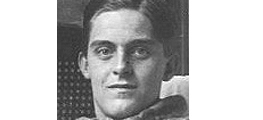
“The chief officer shot one man — I didn't see this, but three others did — and then he shot himself ." "The first officer of the Titanic, Mr Murdock, did shoot himself after the crash."
Titanic & Her Sisters Olympic and Britannic lists a “Whiteley, Thomas” under the “Stewards” section in the passenger and crew lists (p.486 (3.)).
Encyclopedia Titanica gives this brief history of Whiteley:
“Saloon Steward: Thomas Whiteley, 18, from London was a steward in the first class dining saloon. Whiteley later recalled a dinner party attended by Captain Smith, Dr O’Loughlin and J.Bruce Ismay amongst others, at one point ‘Dr. O’Loughlin rose and lifting his glass, exclaimed: ‘let us drink to the mighty Titanic.’ With cries of approval everybody stood up and drank the toast.’ (North Berks. Herald, 20th April 1912 p.2). Whiteley was left behind after the last boats had been launched but swam over to the upturned collapsible B which already wallowed with the weight of thirty men precariously balanced on it. Someone on board hit at him with an oar as he tried to get near but eventually he was able to haul himself aboard.” (Philip Hind, Encyclopedia Titanica (8.))
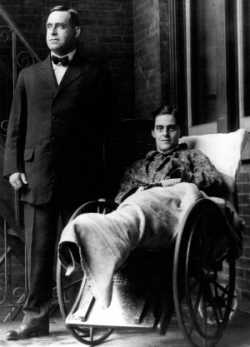
Thomas Whiteley, who was hospitalized
at St. Luke’s with a broken leg and frostbite (4.)
As a waiter/steward, it is expected that he would have a good memory for details and have expertise in overhearing conversations. It is no wonder then that his account is based on hearing three others talk of seeing the incident.
According to Encyclopedia Titanica, “Whiteley was left behind after the last boats had been launched but swam over to the upturned collapsible B” consequently placing him generally in the right time-frame and location. (8.)
The Washington Post of Saturday 20 April 1912 ran the following account:
Whitely, who had helped fill the boats with women, leaped into the sea as the Titanic went down. He was picked up. "There was a bit of panic when it first happened. The officers had to use their revolvers. The chief officer shot one man — I didn't see this, but three others did — and then he shot himself. But everybody, pretty much, behaved splendidly, especially the firemen."(Washington Post, Saturday 20 April 1912)
According to Bill Wormstedt’s Shots in the Dark, Whiteley gave several different versions, but explains: “Whiteley was hospitalized at St. Luke’s with a broken leg and frostbite following his rescue from Collapsible B. Due to this, he gave several accounts of the sinking to the press. Parts of his accounts were based on rumors and hearsay about events he did not see for himself. Also, due to being interviewed by a number of reporters, his story appears to change, due to misquotes from the different reporters.” (12.)
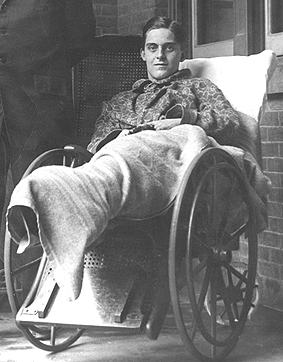
Thomas Whiteley at St Vincent's Hospital.
(Click image to enlarge) (8.)
For this reason, the April 19, 1912 issue of the Bangor Daily Commercial, published an interview in which “the story was changed to say that Whiteley actually saw the whole event: ‘Earlier, during the loading of the collapsible boat on the starboard side, there was a bitter panic. The officers had to use their revolvers. The Chief Officer shot two men but three others attempted to get into the boat. Later, I saw the Chief Officer shoot himself.’” (Bill Wormstedt, Shots in the Dark (12.))
Another account, this time in the April 21, 1912 issue of The New York Herald states:
"Mr Whitney also says he understands that the first officer of the Titanic, Mr Murdock, did shoot himself after the crash. This has been rumored, but never verified... After being thrown from the Titanic while helping to lift women and children into the small boats, Mr Whiteley finally swam to a small boat and was helped in. It was while there that he heard a conversation between the two lookouts, neither of whom he recalled having seen before, but who, he is confident, were on board the steamship. The two men talked freely in his hearing and expressed wonderment that their attempts to get the officer to slow up or take other precautionary methods to avoid the bergs had failed. Mr Whiteley says he carefully marked every word they uttered. "I don't recall the exact words of the men, but I am certain of the sentiment they expressed. They were very indignant. I was particularly astonished when I heard one of them say: - 'No wonder Mr Murdock shot himself.' (New York Herald, Sunday 21 April 1912 )
Wormstedt alleges that the above account is “flawed” because although “all of the lookouts were saved, none were on Collapsible B or No. 4, and all left the ship long before the Boat Deck dipped under… Since the exact sources of Whiteley’s stories are unknown, his testimony must be taken with caution.” (Bill Wormstedt, Shots in the Dark (12.)) While it is correct that it does not seem logical that one of the lookouts would have observed Murdoch’s alleged suicide, it is possible that Whiteley got the identity of the individuals concerned wrong. Floating on an up-turned lifeboat in the middle of Atlantic in the early hours of the morning it is not expected that one could positively identify the sources of such comments. He seems to also have been the victim of misquotation and because of this we should not immediately discount his observations. Even then, his story remains fairly intact –that he overheard talk of an officer shooting a man and then himself.
The New York Times also of Sunday 21 April 1912 ran almost the exactly same report:
Whitely did not know the name of either of the lookout men, and he said he believed they had gone back home on the Lapland. "I heard one of them say that fifteen minutes before the Titanic struck he had reported to First Officer Murdock [sic] on the bridge that he fancied he saw an iceberg," said Whitely. "Twice after that the lookout said he warned Mr. Murdock that a berg was ahead. I can't remember their exact words, but they were very indignant that no attention was paid to their warnings. One of them said: 'No wonder that Mr. Murdock shot himself.'" (The New York Times, Sunday 21 April 1912)
On the same day as the above article,The New York World ran a similarly worded article that goes on to also provide a further information:.
Lookout claims Murdoch Shot Himself
"As we stood there on Collapsible B, each man holding on to his neighbours shoulder fearful every moment that some lurch would send us off again into that icy water, two of the men I knew had been on watch in the crow's nest that night spoke up. 'It's no wonder Mr. Murdoch shot himself,' said one to the other. I asked him why."
"'From the crow's nest we sighted the iceberg that hit us at 11.15,' he replied. 'I at once reported it to Mr. Murdoch. It was not white but a sort of bluish colour plainly distinguishable against the clear sky. Twice afterward I reported the iceberg to Mr. Murdoch. I could not see that he at all varied the Titanic's course. He knew he should have changed his course. He shot himself because he knew it.'" (New York World, Sunday 21 April 1912)
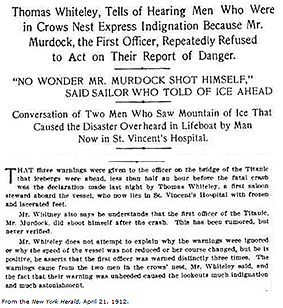
The New York Herald, April 21, 1912.
(Click image to enlarge)
And also on the same day the New York Herald, April 21, 1912 carried a similar story:
Thomas Whiteley Tells of Hearing Men Who Were in Crow's Nest Express Indignation Because Mr Murdock, the First Officer, Repeatedly Refused to Act on Their Report of Danger.
"NO WONDER MR MURDOCK SHOT HIMSELF," SAID SAILOR WHO TOLD OF ICE AHEAD
Conversation of Two Men Who Saw Mountain of Ice That Caused the Disaster Oveheard in Lifeboat by Man Now in St Vincent's Hospital
That three warnings were given to the officer on the bridge of the Titanic that icebergs were ahead, less than half an hour before the fatal crash was the declaration made last night by Thomas Whiteley, a first saloon steward aboard the vessel, who now lies in St. Vincent's Hospital with frozen and lacerated feet.
Mr Whitely also says he understands that the first officer of the Titanic, Mr Murdock, did shoot himself after the crash. This has been rumoured but never verified.
Mr Whiteley does not attempt to explain why the warnings were ignored or why the speed of the vessel was not reduced or her course changed, but he is positive, he asserts that the first officer was warned distinctly three times. The warnings came from the two men in the crow's nest. Mr Whiteley said, and the fact that their warning was unheeded caused the lookouts much indignation and much astonishment. (The New York Herald, April 21, 1912)
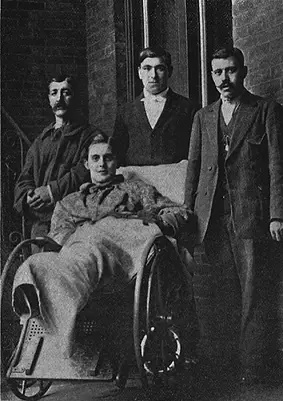
Survivors John William Thompson, Thomas
Whiteley, William McIntyre, Emilio Pallas
Castillo, in New York after the disaster.
(Click image to enlarge) (8.)
Regarding Whiteley's injuries Peter Thresh in his book Titanic writes in a caption to a photograph of Whiteley in a wheelchair with rugs wrapped around his legs: “Thomas Whitely, first saloon steward, whose leg was caught as lifeboats were being lowered.” (Peter Thresh, Titanic, p.71 (4.) ) Cross-referencing this with the information from Encyclopedia Titanica and Shots in the Dark quoted above, it is more likely that the injuries to his legs were caused from being in the water (junior wireless operator Harold Bride, who also sought refuge aboard collapsible B after a period of time in the ocean, had very similar injuries due to badly frozen legs).
Webmaster Richard Edkins writes this about Whiteley (though without any evidence to back-up his statement): “Hearsay; generally considered unreliable. Has been the basis of books by Behe and Gardner that abuse William Murdoch.” (Richard Edkins, Murdoch of the Titanic (1.))The various newspaper accounts from Thomas Whiteley seem to indicate an 18 year old seeking the limelight by making sensational claims, including:
1. A premonition in which while bidding goodbye to some friends at Southampton, he said, "I don't think I shall ever see you again. We are going to have a wreck" (Daily Sketch, April 1912)
2. A dinner toast 'Let us drink to the mighty Titanic' by Dr. O'Loughlin on the night of the disaster (Oxford Times, Saturday 27 April 1912)
3. A 15 minute delay from the birdge after three times reporting the iceberg (New York Times, Sunday 21 April 1912)
4. The iceberg looking a "bluish colour" and thus hard to see (New York World, Sunday 21 April 1912 )
5. Trying to keep Chief Wireless operator Phillips the radio operator warm before he died, (Washington Post, Saturday 20 April 1912)
6. A 'money boat' launched from the starboard side in which a millionaire paid £5 to each of the crew (New York Times, Sunday 21 April 1912)
7. Seeing Captain Smith last moments in which he "last saw the captain he was in the water trying to place a baby in one of the lifeboats crowded with people. Some women tried to drag him on the boat, but he pulled away from them and said: ‘Save yourselves.’ I saw him go under, and he never came up.” (Washington Herald, Sunday 21 April 1912)
However it must be noted that all of the above reports came almost exclusively via a synidcated agency that interviewed him while he was recovering in St. Vincent’s Hospital. In other words, they are almost all third-hand accounts -relating what Whiteley himself had mostly only heard from someone else.
Elizabeth Gibbons picks up on Whiteley's mention of the "lookout men" and assuming they are Fleet and Lee writes:
Whiteley's story is useless except for two things: it demonstrates the great fear conceived by Fleet and Lee that they would be blamed, and it suggests that the belief that Murdoch had shot himself was first expressed while the survivors were still in the boats. But this immediately raises the same problem as No. 13: Fleet and Lee were sent away in No. 6, lowered from the port side at approximately 12:55 am, under the command of Quartermaster Hichens. At 12:55 am, William Murdoch was very much alive. Hichens appears from the testimony of nearly everyone in No. 6 to have panicked once in the ocean, and directed the lifeboat rowed as far as possible from the sinking liner. Thus, by time and distance (and by being on the wrong side of the Titanic) Fleet and Lee could have known nothing about anyone's suicide. From where then did Fleet or Lee obtain their certainty? The most likely probability is that they inferred Murdoch's identity when they heard the suicide discussed on the Carpathia and that Whiteley, who misconstrued so much, misidentified the location of this particular statement also. Fleet and Lee must have been weak with relief to learn that Murdoch was dead; their desperation to avoid being held responsible cannot be overestimated. Lee told British Consul General Walter Bennett in New York (who repeated it to the New York Times on April 26, 1912) that a haze on the horizon prevented the lookout men from seeing the iceberg sooner. Unlike Fleet, Lee lacked the gift of knowing when to stop, and stuck to his "haze" while under oath in London one of the reasons Lord Mersey ordered his testimony stricken. Neither Fleet nor Lee are reliable when not testifying with a perjury statute in force (in Lee's case, not even with one) and can be disregarded insofar as the suicide is concerned. (55.)
Interestingly, Whiteley was never called upon to testify at either of the British or American investigations. Some may assume this because they thought his accounts were too sensational. However, it seems this was more due to an oversight or due to his health condition than deliberate as Chairman Smith of Senate Inquiry was ready to consider the more sensational evidence of a Hungarian named Luis Klein, who alleged he was a surviving member of the crew and that "the officer of the watch was asleep on deck when the Titanic smashed into the iceberg's projecting spur, and that other officers and members of the crew were drunk or drinking. Wine, he said, was being passed out of the cabin" an account that was later discredited (New York Times, Monday 22 April 1912).In fact it does seem that they wanted Whiteley to testify but his health prevented it. According to the same newspaper account "The committee is particularly anxious to get Assistant Steward Thomas Whitely as soon as he can be moved from St. Vincent's Hospital, New York." (New York Times, Monday 22 April 1912).
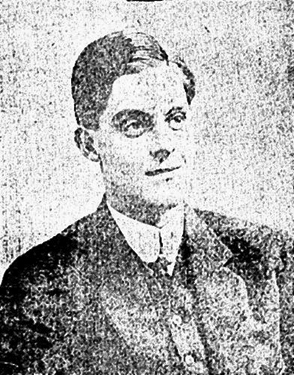
Thomas Whiteley(8.)
From May 1912 he began giving public lectures and was able to tell his full story, providing context to his claims. A full version can be read on the Encyclopedia Titanica website here. But in summary it is a reasonably balanced and informative account, detailing that he spent most of his time on the portside helping Lightoller and that he eventually found sanctuary on upturned collapsible B. He also describes seeing the ship break in two, something that was not verified until the discovery of the wreck in 1985.
And on closer inspection most of his sensational claims hold water. For example, we now know that iceberg warnings did go unheeded and that there was a possible delay before Murdoch made his hard-a-starboard' decision (refer to the updates section). Not only was he given a chance to tell his story but in regard to his account of the lookouts warnings being disregarded he clearly was willing to put his money where his mouth was as in 1914 he filed a law suit against the White Star Line in which he claimed negligent steering and that Titanic had been unseaworthy (Chicago Daily Journal, Friday 16 January 1914) which seemingly was settled out of court as there is no further mention of it.
In January 1914, Whiteley went to court and filed a suit against the White Star Line, accusing The Oceanic Steam Navigation Company of "alleged negligent steering":
Another Titanic case -In Mr Justice Darling's Court yesterday Mr Raeburn, on behalf of the defendants in Whiteley v. The Oceanic Steam Navigation Company (Limited), asked that a day should be fixed for the hearing. He said that the plantiff, who was a steward in the Titanic and was injured, alleged negligent steering and unseaworthiness of the vessel, and it would be necessary for a number of nautical witnesses to attend. He suggested that the case should be heard on March 1. Mr Justice Drling said that the only objection was that the date would fall on a Sunday. Monday March 2, was provisionally fixed for the hearing. (The Times, Saturday January 17, 1914)
There is no further mention of the case so it can only be assumed that it was settled out of court or did not proceed due to lack of funds or evidence. However, it is interesting to think what evidence of "alleged negligent steering" the "number of nautical witnesses" would have considered.
According to Encyclpedia Titanica Whiteley, by 1930, he was living at 66 Melrose Avenue, Los Angeles, his occupation being Moving Picture Actor and later “Cast Director” in a film studio. He died as a Royal Air Force Warrant Officer on 11th October 1944, apparently as the result of cardiac problems, at the age of 50.((8.)).
Conclusion:
Whiteley is clearly not providing first-hand eyewitness evidence, but repeating what he had heard from three men while on the upturned collapsible B. Two of the men he heard this from he described as lookouts and that while he "carefully marked every word they uttered" admitted that "I don't recall the exact words of the men, but I am certain of the sentiment they expressed". He "did not know the name of either of the lookout men, and he said he believed they had gone back home on the Lapland." (New York Times, Sunday 21 April 1912). His other evidence does not raise any substantial doubt over his account of a suicide. In fact it suggests that there are three eye-witnesses we could add to the list.
Verdict: